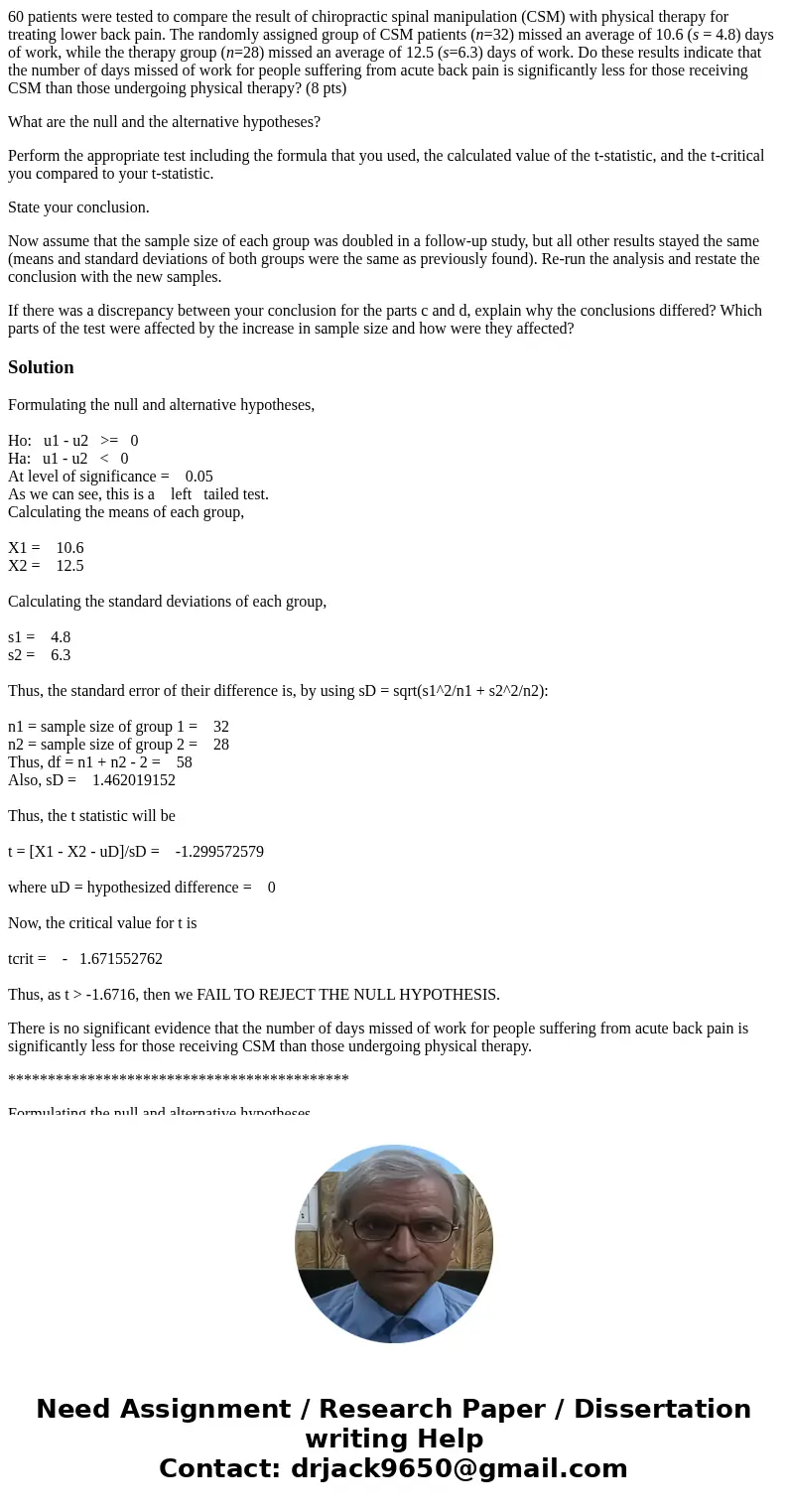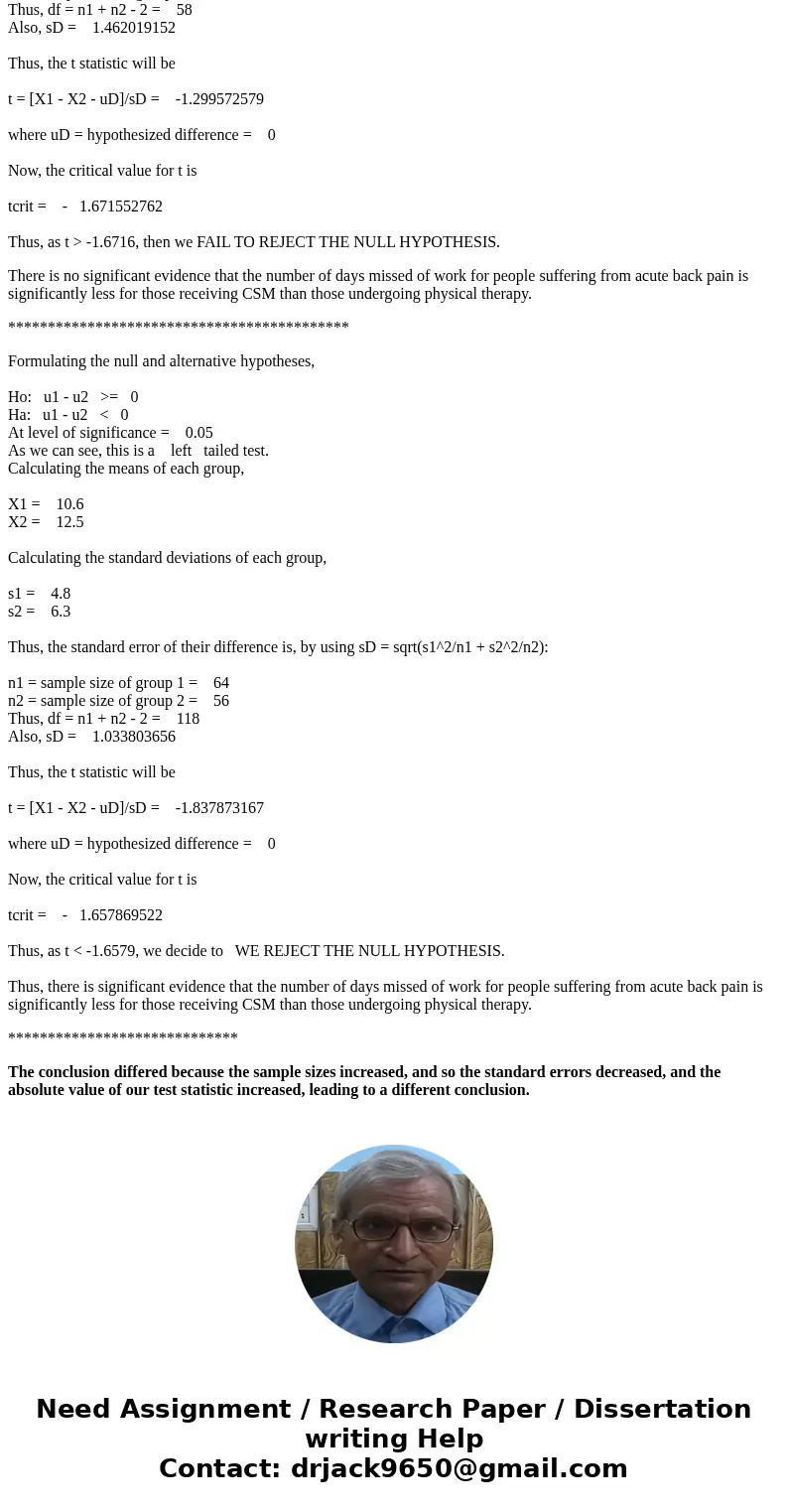60 patients were tested to compare the result of chiropracti
60 patients were tested to compare the result of chiropractic spinal manipulation (CSM) with physical therapy for treating lower back pain. The randomly assigned group of CSM patients (n=32) missed an average of 10.6 (s = 4.8) days of work, while the therapy group (n=28) missed an average of 12.5 (s=6.3) days of work. Do these results indicate that the number of days missed of work for people suffering from acute back pain is significantly less for those receiving CSM than those undergoing physical therapy? (8 pts)
What are the null and the alternative hypotheses?
Perform the appropriate test including the formula that you used, the calculated value of the t-statistic, and the t-critical you compared to your t-statistic.
State your conclusion.
Now assume that the sample size of each group was doubled in a follow-up study, but all other results stayed the same (means and standard deviations of both groups were the same as previously found). Re-run the analysis and restate the conclusion with the new samples.
If there was a discrepancy between your conclusion for the parts c and d, explain why the conclusions differed? Which parts of the test were affected by the increase in sample size and how were they affected?
Solution
Formulating the null and alternative hypotheses,
Ho: u1 - u2 >= 0
Ha: u1 - u2 < 0
At level of significance = 0.05
As we can see, this is a left tailed test.
Calculating the means of each group,
X1 = 10.6
X2 = 12.5
Calculating the standard deviations of each group,
s1 = 4.8
s2 = 6.3
Thus, the standard error of their difference is, by using sD = sqrt(s1^2/n1 + s2^2/n2):
n1 = sample size of group 1 = 32
n2 = sample size of group 2 = 28
Thus, df = n1 + n2 - 2 = 58
Also, sD = 1.462019152
Thus, the t statistic will be
t = [X1 - X2 - uD]/sD = -1.299572579
where uD = hypothesized difference = 0
Now, the critical value for t is
tcrit = - 1.671552762
Thus, as t > -1.6716, then we FAIL TO REJECT THE NULL HYPOTHESIS.
There is no significant evidence that the number of days missed of work for people suffering from acute back pain is significantly less for those receiving CSM than those undergoing physical therapy.
*******************************************
Formulating the null and alternative hypotheses,
Ho: u1 - u2 >= 0
Ha: u1 - u2 < 0
At level of significance = 0.05
As we can see, this is a left tailed test.
Calculating the means of each group,
X1 = 10.6
X2 = 12.5
Calculating the standard deviations of each group,
s1 = 4.8
s2 = 6.3
Thus, the standard error of their difference is, by using sD = sqrt(s1^2/n1 + s2^2/n2):
n1 = sample size of group 1 = 64
n2 = sample size of group 2 = 56
Thus, df = n1 + n2 - 2 = 118
Also, sD = 1.033803656
Thus, the t statistic will be
t = [X1 - X2 - uD]/sD = -1.837873167
where uD = hypothesized difference = 0
Now, the critical value for t is
tcrit = - 1.657869522
Thus, as t < -1.6579, we decide to WE REJECT THE NULL HYPOTHESIS.
Thus, there is significant evidence that the number of days missed of work for people suffering from acute back pain is significantly less for those receiving CSM than those undergoing physical therapy.
*****************************
The conclusion differed because the sample sizes increased, and so the standard errors decreased, and the absolute value of our test statistic increased, leading to a different conclusion.


 Homework Sourse
Homework Sourse